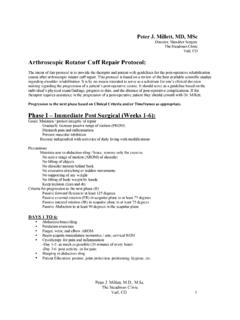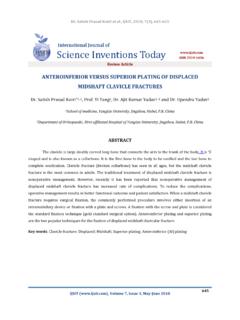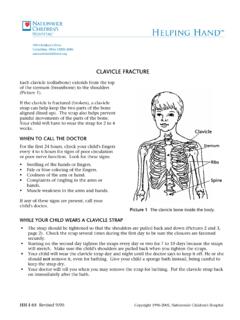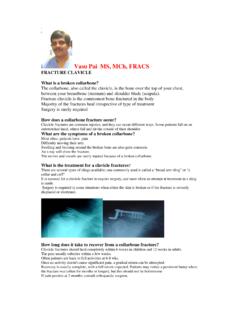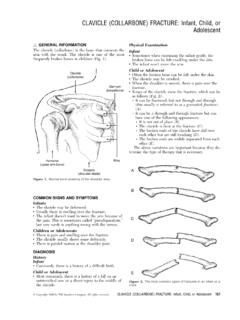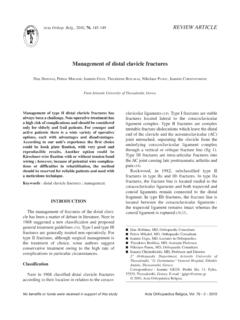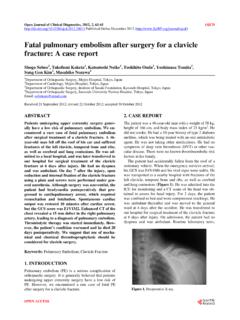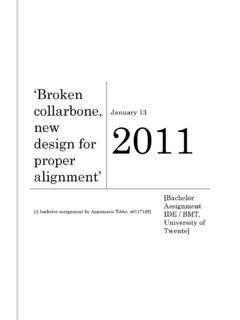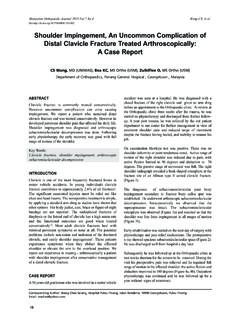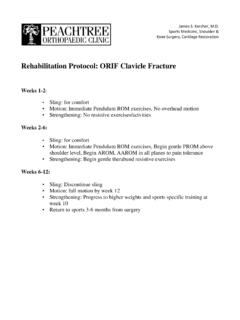Transcription of Treatment of clavicle fractures: current concepts review
1 Treatment of clavicle fractures: current concepts reviewOlivier A. van der Meijden, MD, Trevor R. Gaskill, MD, Peter J. Millett, MD, MSc*Steadman Philippon Research Institute, Vail, CO, USAC lavicle fractures are common in adults and children. Most commonly, these fractures occur within themiddle third of the clavicle and exhibit some degree of displacement. Whereas many midshaft claviclefractures can be treated nonsurgically, recent evidence suggests that more severe fracture types exhibithigher rates of symptomatic nonunion or malunion.
2 Although the indications for surgical fixation of mid-shaft clavicle fractures remain controversial, they appear to be broadening. Most fractures of the medial orlateral end of the clavicle can be treated nonsurgically if fracture fragments remain stable. Surgical inter-vention may be required in cases of neurovascular compromise or significant fracture displacement. In chil-dren and adolescents, these injuries mostly consist of physeal separations, which have a large healingpotential and can therefore be managed conservatively.
3 current concepts of clavicle fracture managementare discussed including surgical indications, techniques, and of evidence: review Article. 2011 Journal of Shoulder and Elbow Surgery Board of : clavicle fractures; Treatment ; current conceptsApproximately 2% to 5% of all fractures in adults and10% to 15% in children involve the ,44,49 Theincidence of this type of fracture in the adolescent and adultpopulation is reportedly 29 to 64 per 100,000 ,49,52 Fractures of the clavicle also showa bimodal age distribution.
4 Young male patients who areaged less than 30 years and elderly patients aged over 70years appear to be two distinct age groups at higher risk forclavicle adults, more than two-thirds of these injuries occur atthe diaphysis of the clavicle , and these injuries are morelikely to be displaced as compared with medial- and lateral-third fractures. In children, up to 90% of clavicle fracturesare midshaft ,43 Lateral-third fractures are lesscommon, accounting for approximately 25% of all claviclefractures, and are less likely to be displaced than thoseoccurring in the midshaft.
5 Medial-third fractures comprisethe remaining 2% to 3% of these ,43,47,49,52,56 Traditionally, nonsurgical management has been favoredas the initial Treatment modality for most clavicle fracturesbecause of the high nonunion rates reported after ,54 Although nonsurgical management may beoptimal for many clavicle fractures, good outcomes ofnonesurgically treated fractures are not ,45,46,53 Recent evidence suggests that specific subsets of patientsmay be at high risk for nonunion, shoulder dysfunction, orresidual pain after nonsurgical thissubset of patients, acute surgical intervention may mini-mize suboptimal outcomes.
6 Therefore, specific Treatment ofclavicle fractures should not be broadly applied but rathershould be individualized based on fracture characteristicsand patient purpose of this review is to provide an overview ofthe current Treatment strategies for clavicle fractures basedInstitutional review board approval: not applicable ( review article).*Reprint requests: Peter J. Millett, MD, MSc, The Steadman Clinic,Steadman Philippon Research Institute, 181 W Meadow Dr, Ste 1000, Vail,CO, 81657, Millett).
7 J Shoulder Elbow Surg (2011)-, $ - see front matter 2011 Journal of Shoulder and Elbow Surgery Board of their anatomic location and stability. In addition, anecessary distinction is made between fractures in adultsand fractures in skeletally immature of clavicle fracturesA number of classification systems have been proposed toaid in the description of clavicle fracture patterns forclinical and research ,12,40,43,52To date, mostmodern clavicle fracture classification systems areprimarily descriptive and not predictive of outcome.
8 Thefirst widely accepted classification system for claviclefractures was described by Allman1in 1967. Fractures wereclassified based on their anatomic location in descendingorder of fracture incidence. Type I fractures occur withinthe middle third of the clavicle , whereas type II and type IIIfractures represent involvement of the lateral and medialthirds, of the lateral third of the clavicle were furthersubclassified by Neer,40recognizing the importance of thecoracoclavicular (CC) ligaments to the stability of themedial fracture segment.
9 A type I lateral clavicle fractureoccurs distal to the CC ligaments, resulting in a minimallydisplaced fracture that is typically stable. Type II injuriesare characterized by a medial fragment that is discontin-uous with the CC ligaments. In these cases, the medialfragment often exhibits vertical instability after loss of theligamentous stability provided by the CC ligaments. TypeIII injuries are characterized by an intra-articular fracture ofthe acromioclavicular joint with intact CC these fractures are typically stable injuries, theymay ultimately result in traumatic arthrosis of the acro-mioclavicular joint.
10 A more subtle fracture may requirespecial radiographic views for identification and may bemistaken for a first-degree acromioclavicular joint more detailed classification system (Edinburgh clas-sification) was proposed by to earlierdescriptions, the primary classification is anatomicallydivided into medial (type I), middle (type II), and lateral(type III) thirds. Each of these types is then subdividedbased on the magnitude of fracture fragment displacement of less than 100% characterizessubgroup A, whereas fractures displaced by more than100% account for subgroup B.
